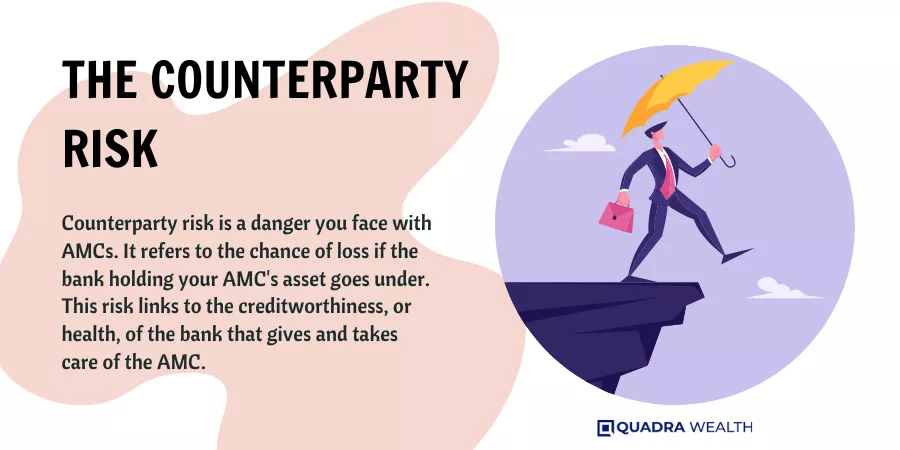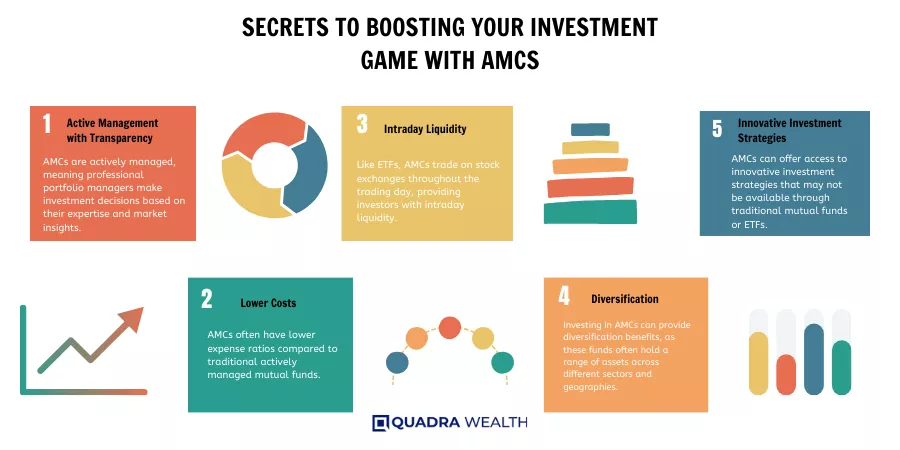Are you looking for diverse, affordable investment solutions? Actively Managed Certificates (AMCs) have seen a surge in popularity, reaching over $1 trillion globally in assets under management.
In this article, we’ll delve into the ins and outs of AMCs – how the Active Management Certificate works, their benefits to banks and issuers, the inherent risks involved, and effective strategies to utilize them.
Ready for an exciting financial journey? Read on!
Key takeaways
●AMCs are a way to put money in different items like equities and bonds.
●They save you costs, match your needs, and give fast results.
●Careful of the risks! If the bank fails or an advisor makes bad picks, it can lose value!
●Still, people love AMCs because they let you change what's inside at any time based on advice given.
Understanding What an AMC is
An AMC is a type of structured product. It gives you dynamic participation in an asset portfolio. The assets can be anything from stocks exchange to bonds, commodities, or other items.
You can change the content of this portfolio anytime based on advice given by your advisor. The issuer and administrator of AMCs could be any reputable institution like a bank or even a trusted company.
They give out certificates are issued for this investment product which serve as proof that you own part of the specified alternative assets they manage. This makes AMCs very adaptable and affordable with quite broad accessibility in investment settings.
The Rise and Popularity of AMCs
AMCs have taken the spotlight in last couple of years. They show fast growth because of their versatility, affordability, and range of uses.
The global AMC market now has more than $1 trillion under liquidity asset management. This rise did not happen overnight though. A big jump happened in the past three years.
It changed what people thought about AMCs before that time. This change was due to the many good things that come with AMCs. One major pull for people is the lower fees it offers clients.
With AMCs, there is less money going into fees and charges which can add up over time! More importantly, they offer greater flexibility for traditional investment strategies based on client needs! retail Investors find this helpful as they want to tailor investment strategies that fit just for them!
Companies also found value in AMCs because it reduces their time-to market opportunities and risk. No longer do companies have to wait ages for products or services to reach customers anymore! With an easier way of diversifying and evaluating performances too, these make up some reasons why more investors are looking towards Actively Managed Certificates!
Together all these factors help drive evolving demand of investors up while increasing room to compete within markets at large.

How AMCs Work
In AMCs, the asset manager routinely adjusts the actively managed investment portfolio to line with market trends and client investment objectives — this presents associated counterparty and market risks.
Actively Managed Certificates are issuance derivative securities: This means that AMCs are not collective investment schemes but are securitized portfolios that are dynamically adjusted at the discretion of an investment manager.
They can be issued as on- or off-balance sheet certificates and are either privately placed or exchange-listed. Any AMC has an Underlying with a separate ISIN number it is linked to.
The global AMC market exceeds $1 trillion in assets under management, with the most significant growth happening in the last three years. Depending on the jurisdiction, these products are also referred to as Exchange-Traded Notes, Dynamic Equity Notes, Strategy Notes, Strategy Index Certificates, and Actively Managed Trackers.
Dive deeper to explore how these factors impact AMCs.

The Counterparty Risk
Counterparty risk is a danger you face with AMCs. It refers to the chance of loss if the bank holding your AMC’s asset goes under.
This risk links to the creditworthiness, or health, of the bank that gives and takes care of the AMC.
Hence, it’s wise to only deal with banks in good standing for your AMCs. This helps make sure it won’t fail and cost you money.

The Market/Portfolio Risk
Prices can move up or down in the market. This is called market risk. It also affects Actively Managed portfolio Certificates (AMCs). Any drop in prices may cause a loss in your AMC investments.
Another thing to note is the portfolio risk managements. This happens when an investment manager makes bad decisions about what to buy for the portfolio management or doesn’t balance it well enough.
The exact mix of things like stocks, bonds, and other assets must be right on point – if not, your AMCs might lose value too quickly.

Benefits of AMCs for Banks and Issuers
AMCs offer banks and issuers several benefits, such as offering a diverse variety of strategies, and not being limited to just mirroring funds or indices.
Stay tuned for more on how these advantages impact the institutions involved in actively managed certificate operations.
Diverse Names and Strategies
AMCs are not new come in many types and plans. There is a fit for all needs. Accessible to a broader like the risky bets.
Others play safe with bonds or stocks. These AMCs use many strategies to meet goals. Each AMCs can also uses a unique name and approach to stand out, and they adapt as needed.
If the markets make a big shift, your AMC shifts too! This makes it easy for you to keep on track without stress or work from your side.

Beyond Mirroring Funds and Indices
AMCs do more than copy funds and indexes. They make it easy to pick from a mix of stocks, bonds, and other property.
You can tailor your picks to your needs. AMCs are not fixed like other investment that combines, they change with the market trends. This helps you keep up with changing times and markets.
In addition, you may see lower fees when using an AMC which saves you money over time.

The Value Proposition and Risks of AMCs
Actively Managed Certificates offer (AMCs) bring a lot of value. They can cut your costs and give you more control. With AMCs, you can shape your own alternative investment plan.
You don’t have to wait for a long time either with their fast time-to-market feature. On top of that, they give clear updates on how well things are going.
Still, there are risks too.
The biggest one is counterparty risk which is about who holds the assets in the AMC. If they fail, it’s bad news for your investments.
Market or portfolio risk affects everything based on how markets behave while investment depending on the strategy risk takes place if the advisor makes poor choices in steering the AMC’s direction.

Conclusion: Key Takeaways in AMC Investment Strategies
AMC investment opportunities give you lots of good things. You save time and money with AMCs. By leveraging these certificates, investment options for investors with different access tailored strategies across diverse wide range of asset classes, while investment decisions managers have the tools to dynamically adapt to market conditions and client needs.
They also let you set up your own plans for where to put your money. Just be sure to think about the different risks profile too!

FAQs
AMCs are structured products market in banking institutions. They deal with an underlying portfolio of assets and follow tailored active investment strategies.
The benefits include diversification from a mix of different transferable securities dealer, a secondary financial market for trading, transparent performance of the underlying assets evaluation, reduced fees compared to normal investment funds, and better control over portfolio managers strategy.
Dynamic portfolio rebalancing accounts for price movements in the underlying assets by tending towards strategic model portfolios or doing tactical allocations as planned by qualified investors who want.
SPVs hold all the custody and safekeeping duties off-balance sheet while allowing high degree of flexibility to experiment without much impact on the regular financial products they offer. When it comes to investment vehicles managed by AMCs, custody and safekeeping are equally optimize for maintaining the integrity and security of investments.
Yes! You’re very right! Using AMCs allows easy customization leading to fast time-to-market resulting in set-up cost efficiency savings which essentially embodies efficiency gains.
Indeed Brokers might use both active investment management & passive investment strategy management techniques interchangeably within their operations thereby creating a diversified range of assets from equities, and loan portfolios to non-bankable assets like real estate and collectibles or digital ones thereby enhancing overall effectiveness.

Why You Need a Personal Financial Manager?
Personal finance management (PFM) is not confined to budgeting and investment any longer. There are

Nearing Retirement Advice for a Secure Future
Nearing retirement advice? A plan for retirement is essential to enjoy a happy healthy life

What is Debt Ceiling? A Complete Guide for Beginners
What is Debt Ceiling? Debt Ceiling, also known as the debt limit, is the highest

Is It Possible to Have No Debt?
Debt is often considered the norm in the corporate world, but the debt free companies





